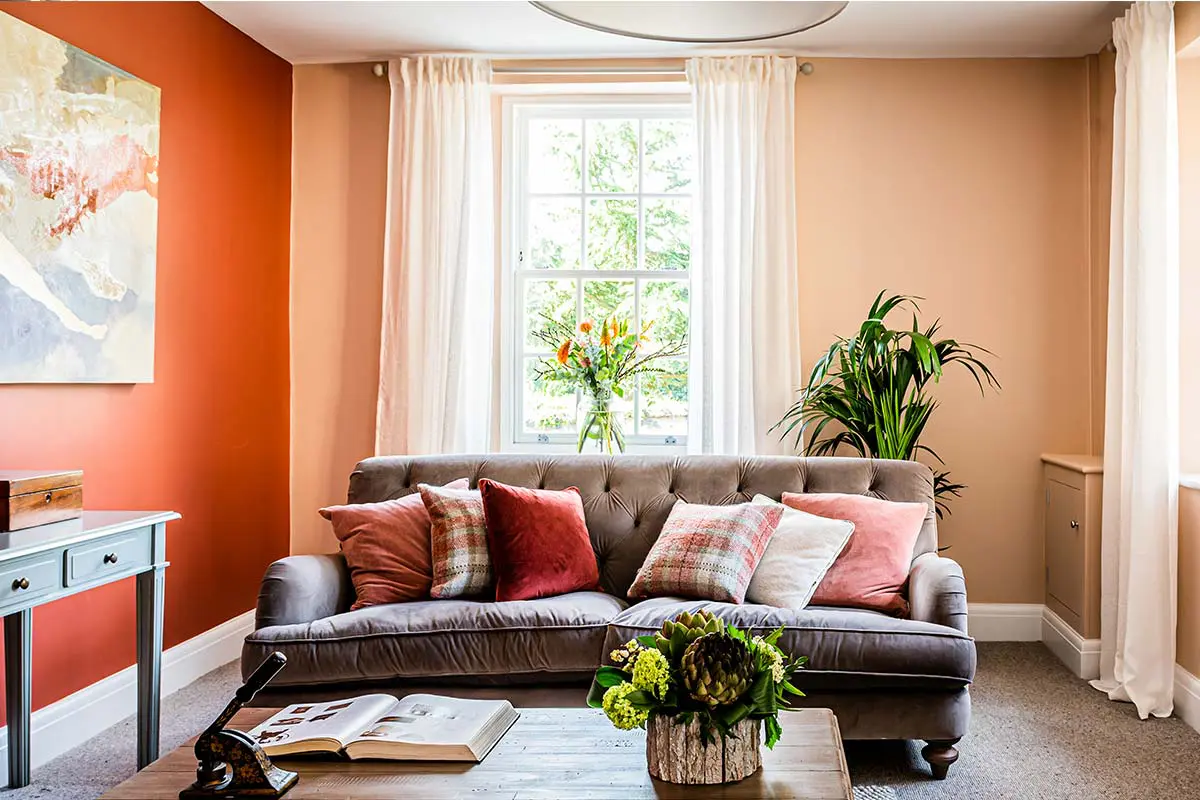The New Part Q & What It Means For You
October 24, 2023 | Blog | Written by Nicola Harrison
As with the introduction of other Building Regulations, Approved Document Q will be phased in. The regulation applies to all new buildings, unless a full plans application, or the building notice was submitted before 1st October 2015 (in which case, the actual work needs to be started prior to 1st October 2016). This means that a developer submitting plans from 1st October 2015 will need to ensure that the buildings comply with Approved Document Q.
For example, if a developer submitted plans for a dwelling on 13th September 2015, the dwelling would not need to comply with Approved Document Q. However, they would need to start building before 1st October 2016 in order to be exempt.
The following table summarises the various scenarios, showing when a developer would and would not need to comply:
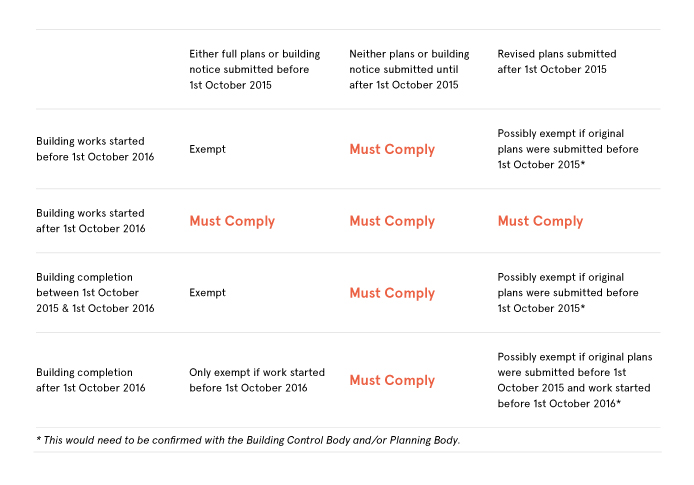
What is the requirement?
The absolute requirement of Part Q is defined in one paragraph on page 2 (Requirement QI) of the approved document with the rest of the document providing guidance as to how it can be met. Requirement QI states:
Reasonable provision must be made to prevent unauthorised access to:
- Any dwelling
- Any part of a building from which access can be gained to a flat within the building.
Approved Document Q is designed to ensure the prevention of unauthorised access to dwellings (including flats). As part of this, doors and windows or roof lights which could be accessed will need to resist physical attack by a casual or opportunist burglar. They therefore must be sufficiently robust, fitted with appropriate hardware and most importantly, be proven to have security performance.
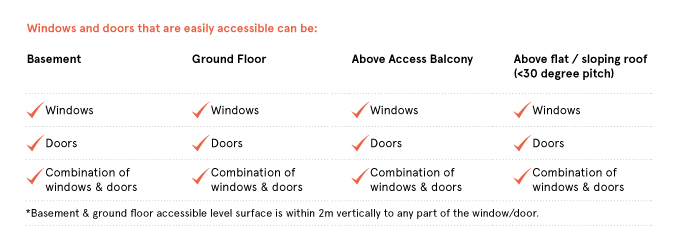
What does easily accessible include?
The following image and extract is taken from the Departments for Communities & Local Government document: Housing Standards Review Security in new dwellings.
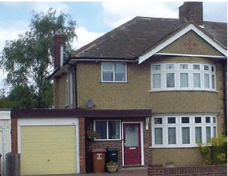
Departments for Communities & Local Government:
The Housing Standards Review Security in new dwellings 2015
All the windows and doors in the photo are deemed to be easily accessible.
Either:
- a window or doorway, any part of which is within 2m vertically of an accessible level surface such as the ground or basement level, or an access balcony, or
- a window within 2m vertically of a flat or sloping roof (with a pitch of less than 30°) that is within 3.5m of ground level.
The ways to comply
1. Test evidence
Test reports can be obtained which exactly match the specification of the product that the manufacturer is supplying. In most cases the size of the products will vary, so test reports will need to be obtained for each and every size purchased.
2. Where the manufacturer is using third party certification (Windows & Doors)
The manufacturer can obtain third party certification on the product, with a scope of approval that includes the product that is being supplied.
3. Product is designed in accordance with Appendix B (Doors only)
The Approved Document includes an Appendix B, which allows the manufacturer to build their doorsets to a pre-determined specification.
“Third party certification to PAS24:2012 or an equivalent standard exceeds the requirements of Approved Document Q. It is also the requirement for Secured by Design approval. The use of third party certified doors, windows and rooflights should simplify the process for approval by the Building Control Officer. In addition, under our new National Building Approval scheme, Secured by Design can approve a house type so that it can be built with security exceeding the legislative requirements in all parts of the UK. However, Secured by Design will only approve the house type when the doors,windows and any roof-lights are third party certified.”
Mick Reynolds – Secured By Design
Responsibility for reviewing test evidence
The following table sets out who is responsible for reviewing test evidence against the product being supplied.
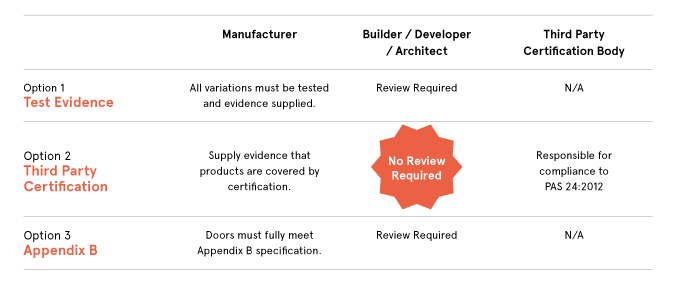
Responsibility for compliance – People who are responsible for building work (e.g. agent, designer, builder or installer) must ensure that the work complies with all applicable requirements of the Building Regulations. The building owner may also be responsible for ensuring that work complies with the Building Regulations. If building work does not comply with the Building Regulations, the building owner may be served with an enforcement notice.
An extract from Approved Document Q: Security
What to be aware of
1. Where the manufacturer is using test evidence
Given the bespoke nature of windows and doors, it simply would not be economically feasible to have testing carried out to cover every variation of design and size.
Developers will need to obtain evidence from the manufacturer of their doors and windows to show that the products they are purchasing have been proven by test to comply with either PAS 24:2012, or another standard that has equivalent or better performance (STS 201, LPS 1175, STS 202 and LPS 2081 are listed in the Approved Document).
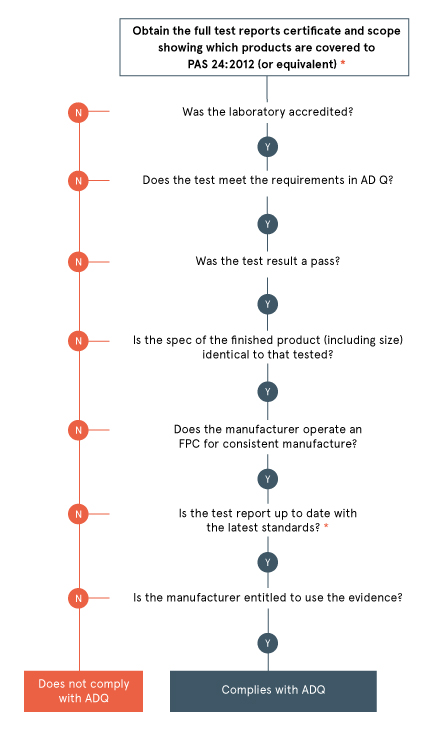
If a manufacturer supplies test evidence to EN1627, they will also need to demonstrate compliance to Annexe A of PAS 24, which is not covered by EN 1627.
2. Where the manufacturer is using third party certification
The second option is for the manufacturer to obtain third party certification on an enhanced security scheme from a recognised UKAS body, with a scope of approval that includes the product that is being supplied. This is acceptable because the certification body is putting their name to the variations from the tested product, which gives it the same credibility as test evidence.
This has the advantage of not only providing increased confidence in the product through factory production control and audit testing requirements that are part of the enhanced security certification, but also ensures products are tested to the latest standards. The products conforming to these schemes will also be listed as part of that certification.
As the guidance suggests UKAS accredited test laboratories should be used. It follows that if using the certification route, the certification body must also be accredited. Secured by Design (SBD) New Homes 2014 design guide has lists of these certification bodies with compliant manufacturers listed on the SBD website.
Most third party certification bodies will also have a search facility on their website which will allow you to identify companies that are certified by them.
3. Where a doorset is designed and manufactured in accordance with Appendix B
If the manufacturer is claiming compliance via Appendix B, the buyer should note that there are a number of security aspects set out in this addition that are extremely onerous, have little flexibility and all of which MUST be adhered to. These cover:
- Door sizes
- The materials they are constructed from.
- The dimensions of rails, stiles, munitions, rebates & panels.
- The locks, hinge types & hinge bolts.
- Use of door limiters.
- Letterplate sizes and positioning.
- High security glazing.
It would be the buyers responsibility to ensure ALL these are met to the standards referenced in appendix B. Three of these in particular are: 1. Door Size 2. Density 3. Panel Sizes
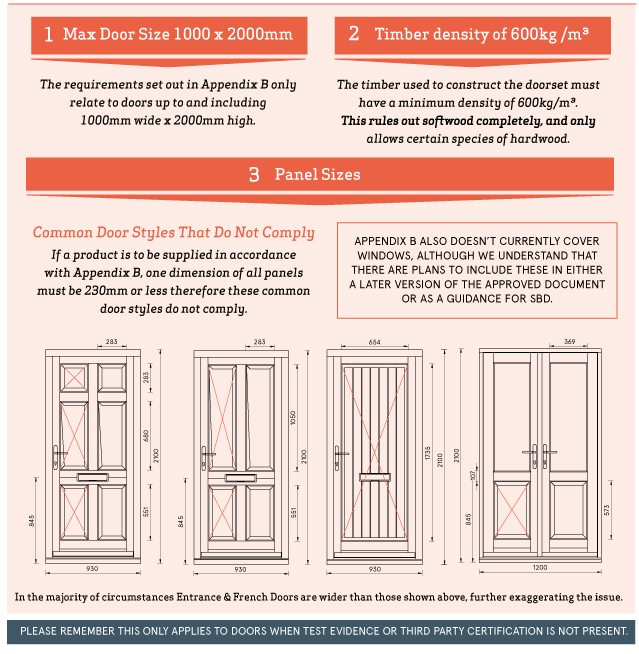
The cost & consequences
The costs associated with compliance
Developers should expect there to be a price difference between a company that has complied and one that has not. It is important to check the detail when comparing suppliers, to make sure that you are comparing similar specifications and that the products comply with the regulations.
The associated costs of complying may not be as you expect. Certification may initially appear to be more onerous for the manufacturer, and you might therefore expect that the cost of a compliant product may be more when the manufacturer has taken this route. For example, a supplier who has no certification or test evidence, would then need to use hardwood, which will significantly increase cost of the product. Without test evidence or certification, the majority of Entrance and French Doors designed with panels couldn’t be purchased either, which would compromise the whole building design.
The consequences of getting it wrong
This is potentially the million dollar (or pound) question as a developer is likely to stand to lose a lot of money if caught out on this one.
We believe there are 3 main scenarios as follows:
Scenario 1
Initially, you could have windows installed into your building and then find that the Building Control Body is unwilling to sign them off without proper evidence.
What Happens
This may not happen at the outset, because as with all new regulations, it can take a while for enforcers to get up to speed. However, as the enforcement bodies get to grips with Approved Document Q, they are more likely to spot problems.
When this happens, you would be at best looking at a delay while the manufacturer proves that the product actually complies. If all goes well, they will book into a test laboratory, test their window, and it will pass.
Consequences
This would involve lead times of up to 8 weeks to produce the windows or doors (which need to be to the exact specification to that fitted), another 6 weeks for the test slot to be available, followed by a lead time for the report to be written, which often takes a minimum of 6 weeks from the test date. It is likely that multiple products would need to be tested to cover all those supplied.
The question to ask yourself then is what the impact of a minimum 20 week delay would be on the building project?
Scenario 2
The window or door may not actually pass the test. (Test labs would probably agree that they often don’t pass first time).
What Happens
You would then have to wait for the lab to be free again in order to re-test for a pass result. This may take several attempts before a positive result has been achieved. Once presented with the new test, the enforcement body should check that the tested specification is the same as that installed in the building.
Consequences
Because some redesign was required to pass the test, it won’t be the same so all of the installed windows and doors would need to be either re-worked or replaced.
Scenario 3
What happens in the situation where non-compliance with the regulation is not spotted before the building is signed off?
What Happens
There is a possibility that an opportunist burglar(s) subsequently finds that they can easily enter the houses on an estate.
Consequences
If an insurance company finds out that the building is in a possible breach of the Building Regulations they may refuse to pay out to the client. It isn’t difficult to remove a window and put it through the test, so it is possible that the insurance company may request this to prove, beyond doubt, that the window or door is in breach of the Building Regulations. Once that has been proven, the insurance company will only need to work out who to put their losses on to, with the developer being the first likely port of call.
As well as potentially costing huge sums of money, all of the above scenarios, plus that non compliant product could also be reported to building control, are likely to cause reputational damage to the developer.
What are the likely further developments with Approved Document Q?
We understand that work is in progress to include windows in Appendix B. However, in order to facilitate this without testing and certification, it is likely that the specification required will have similar restrictions to that outlined for doorsets. This is unlikely therefore to be a viable alternative to testing and certification.
The Approved Document currently only applies to new dwellings. However existing dwellings are equally at risk from attack and it isn’t difficult to imagine the regulations rapidly evolving to the point where eventually it covers extensions and replacement windows and doors. There isn’t really an option to ignore this regulation, so you might as well deal with it now.



